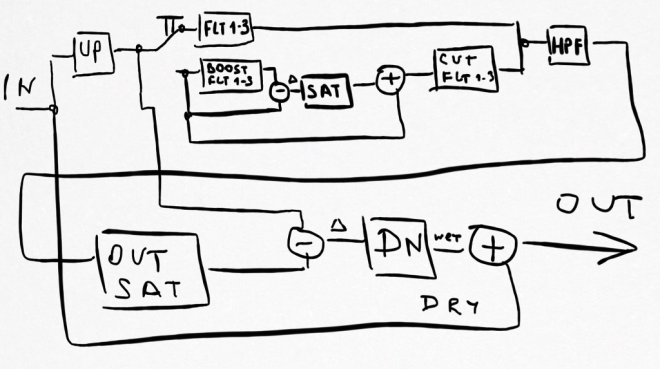Note: Some of the tips rely on features from the GE version.
Mixing against HP/LP combo
A good generic practice when EQing several tracks in a mix is too start by dialing in HP/LP combinations by an appropriate level and then do further EQing/mixing against those settings. Also using the tilt filter is a good idea to apply very first and rough tonal corrections and then working out the details afterwards with the three EQs.
Preserving low-end energy when high-pass filtering
A cool trick to preserve some low-end energy when high-pass filtering is applied is to boost the low-end while using the EQ-SAT feature. As you can see in the routing diagram the HPF comes after the main EQs and EQ-SAT. This way, harmonic overtones are generated based on the fundamentals before the HPF is applied.
Decoupling the low-end
The low-end EQ features a “Phi” option switch which allows to decouple the low-end by an allpass filter network. The crossover can be freely adjusted with the normal frequency control in this band while the gain control does not have any effect in this mode. This may work great for that mellow bass drums just as an example but in other cases it might loose some definition as a trade-off.
Compare different settings
SlickEQ contains two effect settings slots, A and B. Use them in combination with the automatic output gain control to AB test different settings. Within the plugin you can move settings between A and B but also copy&paste is there to freely copy settings between different plug-in instances. Also, undo/redo comes in handy here.
Adjusting precise values
The gain/frequency displays can also be used to enter specific values and also shortcuts are accepted, e.g. “5k” can be entered to set a value to 5000. And did you know that SlickEQ has mouse-wheel support?




Nice tips.
Regarding to “preserving the low end”: imo people should spend some time in understanding dB values. Most people I met always highpass per default. But the real tragedy is that most of them always highpass at a specific frequency (“I always highpass @ 50hZ”) and on top of that they often use a pretty steep filter slope for that (eg. 24/48/96db oct slope) with the result that lot´s of low freq information is missing and the whole mix sounds pretty flat and hollow.
I wish people would understand that such a behaviour is pretty drastic. Most of the time your lowend just needs a little bit of adjustments like -3db or -6db in a specific range to even out the whole signal. And -3dB or -6 dB is a lot in audio terms (well at least for me). A 6dB decrease @ 30hZ is maybe everything your mix/bus/track needs. Please don´t use a 96db oct HP @ 100 per default and later stalk forums and ask “how to get that prominent lowend” back.
And thx to your (Bootsy) blog I totally got rid off the “always cut, never boost” behaviour. That´s another “bad behaviour” imho. Especially if the EQ comes with such nice curves like Slick.
Good job guys.
Regards
Sebastian
Some calculations for highpass @ 50 Hz:
-3 dB @ 50 Hz for all cases
-16 dB @ 20 Hz for 12 dB/Oct highpass
-24 dB @ 20 Hz for 18 dB/Oct highpass
-32 dB @ 20 Hz for 24 dB/Oct highpass
I think it’s nice addition to your comment 🙂
Wow, that´s steep. Thx for the calculations.
Since I discovered that -6dB + -6dB = -3dB aka double as loud (I really don´t know which kind of “loudness) I understood the principle of a linear system. Anyway, as a rough guideline for me all 3dB something doubles or gets halfed …layman terms. Some kind of magic number for me 😀
And 32 dB difference between 20Hz & 50Hz is pretty hefty.
Regards
Sebastian
si, ma ragazzi a me non và?
non me lo carica come vst
The decibel (dB) is a logarithmic unit used to express the ratio between two values of a physical quantity… Let’s repeat… Logarithmic (Not Linear).